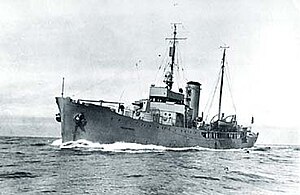HNoMS Fridtjof Nansen (1930)
 The Fridtjof Nansen at sea
| |
| History | |
|---|---|
| Name | Fridtjof Nansen |
| Builder | Marinens Hovedverft in Horten |
| Launched | 5 November 1930 |
| Commissioned | 29 May 1931 |
| Decommissioned | 8 November 1940 |
| Fate | list error: <br /> list (help) Ran aground on an unmarked shallow and sank outside Jan Mayen 8 November 1940 |
| General characteristics | |
| Displacement | 1,275 tons |
| Length | 72.8 metres (238.85 ft) |
| Beam | 10.5 metres (34.45 ft) |
| Draft | 5.7 metres (18.70 ft) |
| Propulsion | list error: <br /> list (help) 2000 hp Lenz steam engine, 2 shafts |
| Speed | 15 knots ([convert: unknown unit]) |
| Range | 7,000 nautical miles (12,964.00 km) |
| Complement | 70 men |
| Armament | list error: <br /> list (help) 2 x 10 cm (4 inch) guns 2 x 47 mm (1.85 inch) automatic guns |
HNoMS Fridtjof Nansen was the first ship in the Norwegian armed forces to be built specially to perform coast guard and fishery protection duties. Command was assumed 29 May 1931 by Commander Ole A. Blom. She was built as build number 118 at Marinens Hovedverft in Horten.[1]
Name
She was named after Fridtjof Nansen - the great Norwegian explorer, scientist, diplomat and Nobel Peace Prize laureate.
War service
At the outbreak of war with the German invasion of Norway 9 April, 1940, Fridtjof Nansen was posted to the Finnmark detachment of the 3rd Naval District covering North Norway. After surviving several air attacks without damage during the Norwegian Campaign Fridtjof Nansen was one of the thirteen Royal Norwegian Navy vessels that made it to the UK, as she escaped westwards at the dawn of the June 10 1940 mainland Norwegian capitulation. On June 8 1940 she took on board in Tromsø Rear Admiral Henry E. Diesen and foreign minister Halvdan Koht in addition to some other refugees. She arrived at Tórshavn on the Faroe Islands on June 13 and later sailed to Great Britain where she was made war ready. 29 August 1940 she was posted as a patrol vessel in Iceland to reinforce the British naval forces there. On November 8 she ran on an unmarked shallow outside the Norwegian arctic island of Jan Mayen and sank. The crew of 67 was all saved.
See also
Notes
- ^ Lokalhistorisk arkiv i Horten kommune: Byggenummer ved Horten verft Template:No icon
Source
- Abelsen, Frank: Norwegian naval ships 1939-1945, Sem & Stenersen AS, Oslo 1986, ISBN 82-7046-050-8 Template:En icon/Template:No icon
- Royal Norwegian Navy Template:No icon
- Royal Norwegian Navy Template:No icon
- Naval history via FLIX: KNM Fridtjof Nansen, retrieved 17 March 2006 Template:En icon
